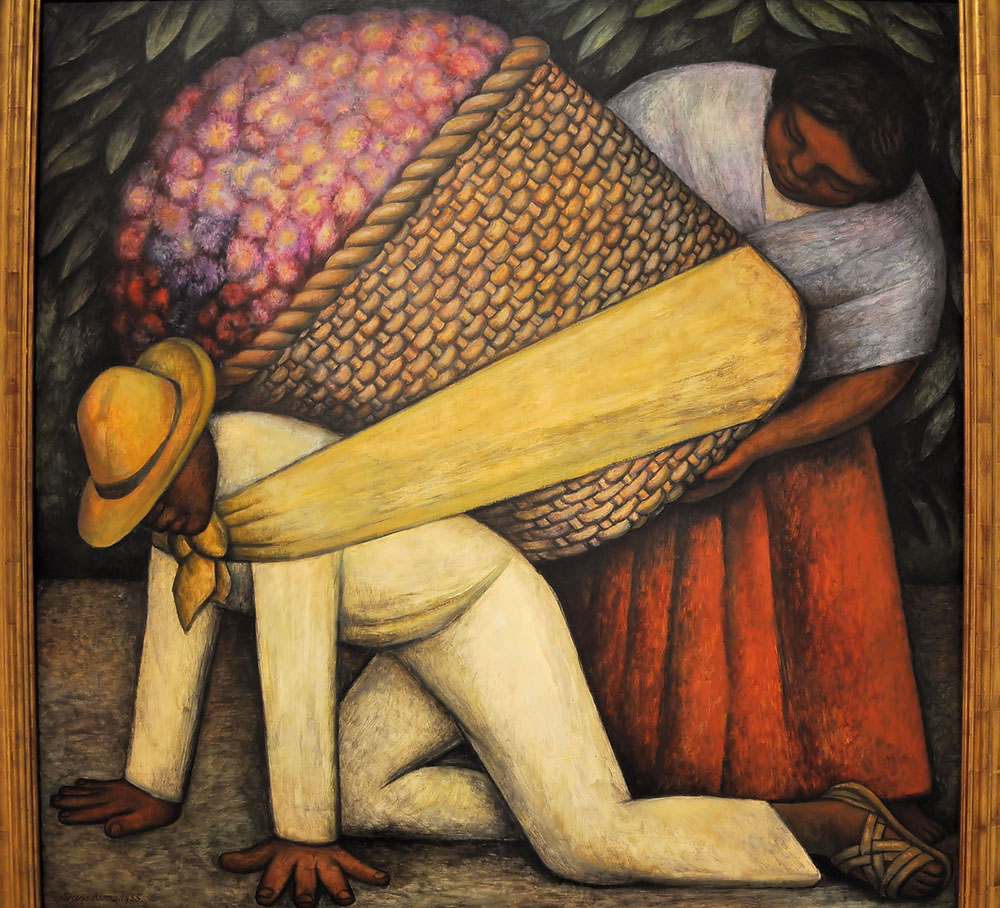
Diego Rivera's painting "El Cargador de Flores," or "The Flower Carrier," is seen at the San Francisco Museum of Modern Art. (Dreamstime/Enrique Gomez Tamez)
Shortly before convening the synod on synodality — arguably the most important Catholic Church gathering since Vatican II — Pope Francis visited Mongolia. Mongolia? Situated precariously between Russia and China, the ancient home of Genghis Khan boasts a total of some 1,450 Catholics midst a population of 3 million.
Why on earth would an aging pope who would be welcome in many powerful nations with huge Catholic populations bother the hardship traveling to such an insignificant spot? Could he have found a smaller Catholic population anywhere in the world? (Well, yes. Vatican City's population is just over 500, so Mongolia beats them by numbers if not by percentage, and there are a few others as well.)
Unlikely as it seems, Mongolia, with a national population less than half that of Mexico City, has a cardinal — Giorgio Marengo — the church's youngest and a member of the synod on synodality.
What was the point? It seems that this was one more opportunity for Francis to demonstrate what he thinks it means to be a shepherd.
Today we celebrate the "Solemnity of Our Lord Jesus Christ, King of the Universe." That's a mouthful! Pope Pius XI established the feast in 1925 to recall that Christ should reign in the hearts and will of humankind.
The readings for the day, different in each year of our three-year liturgical cycle, orient and describe the celebration better than its grandiose title.
The centerpiece today is Matthew's scene of the judgment between sheep and goats (an unfortunate disparagement of the poor old goats who are generally smarter, albeit feistier, than sheep). Michelangelo gave us a vivid image of this scene in which Christ's arm is raised in judgment, the saints are rising and the damned are pitifully drifting into the abyss. Such works vividly depict a fearsome last day.
Jesus' parable offers a different interpretation of the end. In Jesus' parable, the end is ever-present. The coming of Christ is not some future event, but an everyday occurrence and not at all like the Sistine Chapel.
If we want artistic renditions of Matthew's depiction of judgment, we might better read Charles Dickens or study the photography of Dorothea Lange.
Rather than talk about an apocalyptic end, Jesus claimed that the king appears in the guise of every needy person and that we judge ourselves in our response to them. Along these lines, Diego Rivera's painting "El Cargador de Flores" probably reflects this parable more truly than Michelangelo's "The Last Judgment."
Advertisement
Rivera depicts a peasant on his hands and knees. His wife struggles to help him stand up under the weight of an enormous basket of flowers to take to market.
The message for anyone who has eyes to see is that some people's luxurious decor comes at the expense of the poor who cannot even see the beauty of what they bear on their backs.
This is where the vocation of the shepherd comes in. In a universe in which we have been given the ability to choose whether to advance the reign of God or to frustrate it, every follower of Jesus is called to be a shepherd. Every person has the ability to see what Dickens, Lange and Rivera point out, thus every one of us has a responsibility to respond.
Francis went to one of the smallest and least important churches in the world to help the rest of the world see through a different lens.
Francis' missionary journey to Mongolia interprets the 3,000-year-old Psalm 23 with 21st-century symbolism. Francis refreshed the souls of people insignificant in the eyes of the world. That proclaimed one message to people who feel insignificant and another to those who don't notice them.
The coming of Christ is not some future event, but an everyday occurrence.
By making the Mongolians — and all whom they represent — more visible, Francis highlighted their right to enjoy the verdant pastures of our Earth. In the full sight of all those who disparage the small, he spread a lavish table and celebrated the Eucharist with almost every Catholic in the country.
We celebrate this Solemnity of Our Lord Jesus Christ, King of the Universe, on the heels of the first session of the synod on synodality. The synod is calling us to learn how to journey together as church and as the people of the world.
These two events combine to exhort us to recognize that what is truly important in our day is the life of the flower carriers — all those people burdened in a world that loves what they provide, but rarely, barely remembers that they are the ever-present representatives of Christ the King.
When we learn to treat them as such, we will be on the right side of history — all the way to the end.







